San Fransokyo Wharf
Background
When California Adventure opened, Pacific Wharf was one of several “sub-districts” grouped into the Golden State land. Though it didn’t actually contain any rides, the elaborate food court was nonetheless one of the park’s more nicely crafted original areas, with guest seating on docks and boardwalks over a rocky inlet representing San Francisco’s wharf area. (It also offered the popular Boudin Bakery Tour and Mission Tortilla Factory – two small self-guided walkthroughs that included free samples of the finished product.)
In 2012, Pacific Wharf was upgraded to official “land” status, absorbing another “sub-district,” The Golden Vine Winery with the eponymous restaurant and the Blue Sky Cellar nestled into the south side of Grizzly Peak. And all seemed well with the world. But at the D23 Expo in 2022, Parks Chairman Josh D’Amaro breezed past an unusual announcement…
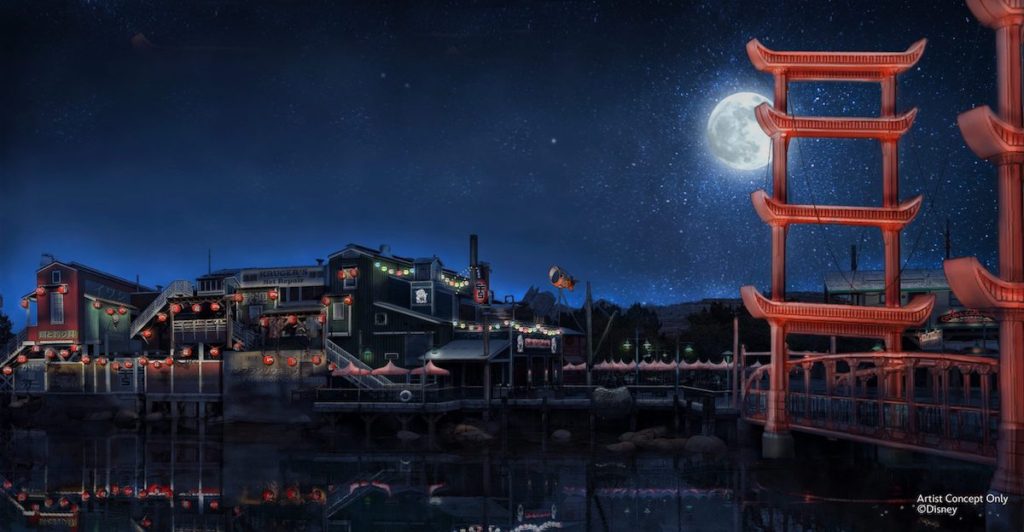
That without much pomp and circumstance, Pacific Wharf would be renamed San Fransokyo in an ode to the city from Disney’s Big Hero 6. The whole “transformation” is apparently completed by hanging paper lanterns throughout the food court and turning the (very small) bridge into the land into the movie’s Torii Gate Bridge (the park’s second squashed-and-stretched cartoon-proportioned Golden Gate Bridge, if you’re counting).
Frankly, that bothers me. First of all, because it’s an obvious “label slap;” as if someone noticed that the park had one area left without an IP tie-in and decided to fix it with a largely nominal swap that contributes nothing of substance.
Second, because I actually included a San Fransokyo land in my from-scratch Fantastic Worlds park (above), and in the process, learned a whole lot about the in-universe history and architecture of the city.
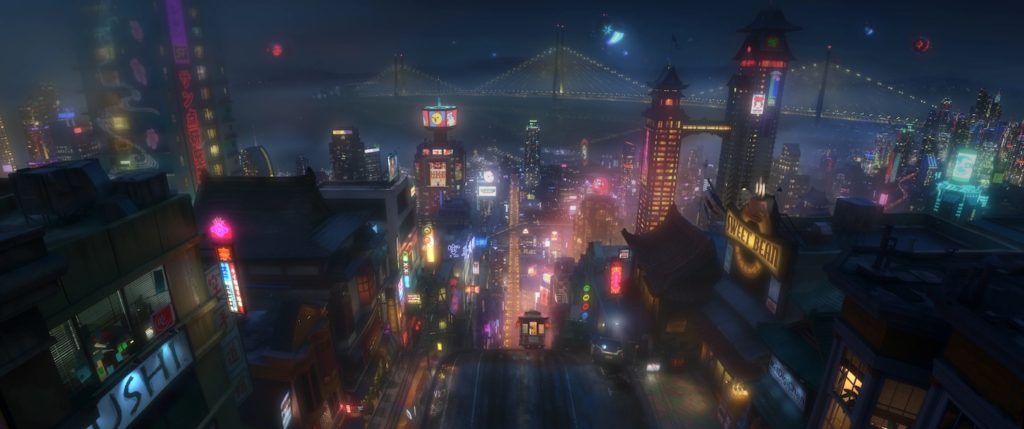
San Fransokyo is a stunning alternate-reality metropolis of futuristic technologies and Eastern architecture, born of the assistance of the Japanese in rebuilding San Francisco after the real 1906 earthquake. This is a vibrant cultural crossroads city of video screens, floating wind turbines, street trolleys, bullet trains, and superheroes… Just saying, “Eh, we’ll put up paper lanterns and have a Baymax meet-and-greet and call it San Fransokyo” is… cringey.
Which is a double shame, because actually, San Fransokyo does make sense as a land in California Adventure, if it were done right! And to be honest, there is not room to do San Fransokyo right in Pacific Wharf, which cannot support a sizable ride at all. So I decided to do what has been done plenty in California Adventure: adjust boundaries.
Build-Out
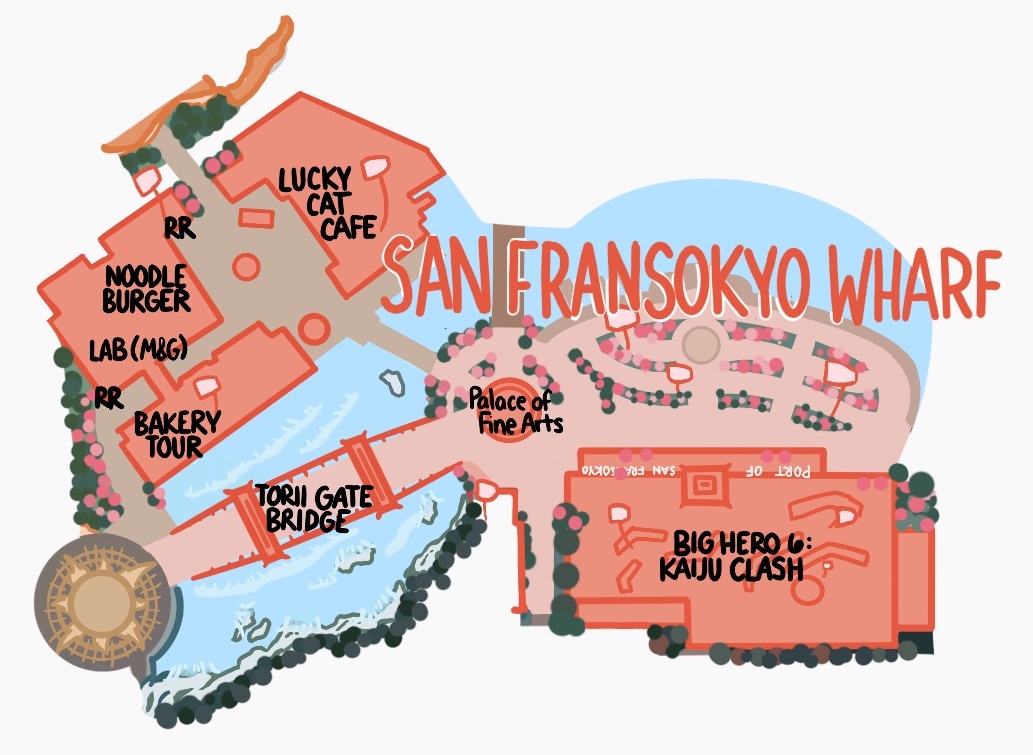
My initial build-out of California Adventure did not include a San Fransokyo land. (Instead, it left Pacific Wharf in-tact and barely changed the existing Paradise Gardens area.) Like I said, San Fransokyo totally belongs in California Adventure if it can be done right. The reason I didn’t include it is because I already used the idea of “alternate San Francisco” in Discovery Bay earlier in the park, and because I really loved the San Fransokyo I developed for Fantastic Worlds and knew I couldn’t beat it in California Adventure’s footprint.
But now, given the fact that a San Fransokyo is happening, I decided to tackle the problem head on. First, I adjusted the land’s name to San Fransokyo Wharf. While perhaps subtle, it’s an important distinction in my head. Instead of making the absurd claim that this wooden food court is standing in for the massive, futuristic city from the film, now we claim only that it’s representing one district – the waterfront wharfs – and that the rest of the city exists just “off-screen”, you know?
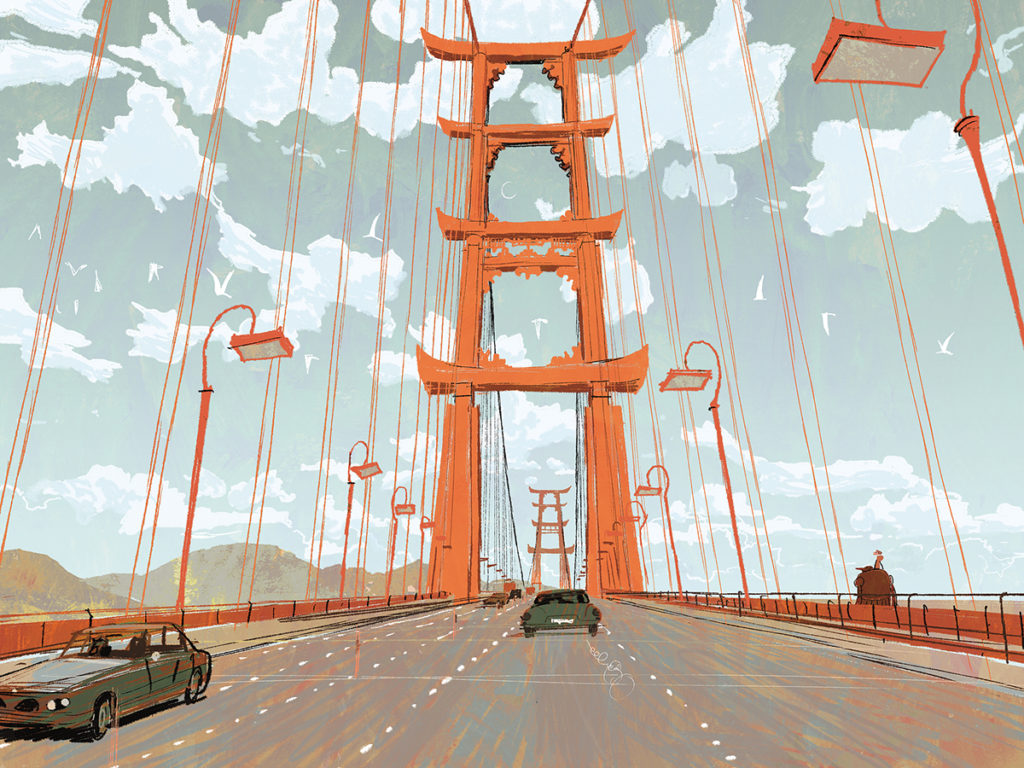
Otherwise, I knew this land needed a proper build of the film’s Japanese-influenced variant of the Golden Gate Bridge. Simply painting the existing iron bridge to Pacific Wharf “international orange” and affixing torii gates to it (which is what happened in the real world) only gives the park a second stretched-and-skewed, out-of-scale Golden Gate Bridge parody. So instead, I decided to carve out this section of the park’s performance corridor “spine,” removing the Golden Vine Winery to open up this valley between Pacific Wharf and the rocky, forested slopes of Grizzly Peak.
I rebuilt the performance corridor as a much more impressively scaled TORII GATE BRIDGE (while maintaining the width needed for parades) and installed a wave machine beneath the food court so waves would roll under the bridge and crash against the new rocky base of the peak. (When you look at this version of the bridge then see the little tiny connector leading to the food court that Disney really-for-real converted to the Torii Gate, you’ll understand the importance of thinking big.)

The real Big Hero 6 “land” at the park includes a small Baymax meet-and-greet, but I wanted to create something more substantial. So I kicked out the Ghirardelli shop and used the space as HIRO’S TIDAL LAB – a small space with real “science center” interactives focused on studying the water cycle and California’s waterways. I figured that would be a “win-win,” turning a retail space into an “attraction,” sneaking in both some science and and some California, and providing a purpose-built space from which meet-and-greets could extend. That seemed to turn the food court into a more robust area.
Speaking of the food court, all I did there is what Disney’s really-for-real done: make even swaps and slap labels on existing eateries, turning the Lucky Fortune Cookery into NOODLE BURGER and Cucina Cucamonga into LUCKY CAT CAFE. You can’t really mess with the BAKERY TOUR since it’s a main bakery for the resort, so you might as well also keep the PACIFIC WHARF CAFE a a nod to the land’s former life.
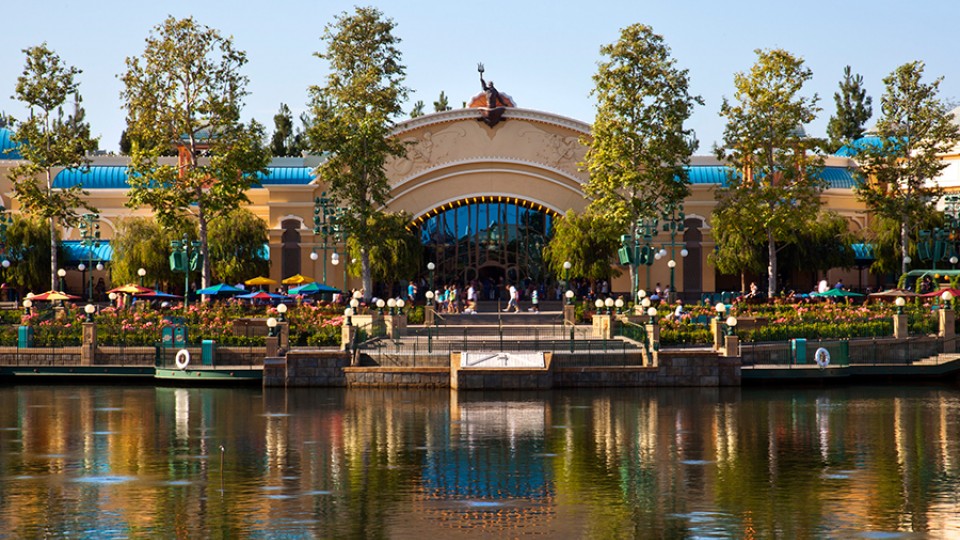
As I said, one of my biggest complaints with the way Disney actually brought San Fransokyo to life is that it’s “full of sound and fury, signifying nothing.” The “land” doesn’t even contain so much as a spinner, much less a real, headlining ride like Big Hero 6 deserves.
In order to at least try to make this land a substantial one, I made the controversial decision to extend San Fransokyo Wharf to overtake part of the current Paradise Gardens – namely, the Little Mermaid dark ride and the Paradise Gardens viewing area for World of Color. Again, in my first draft of a California Adventure reimagining, I left this area alone. The Little Mermaid was “my” Disney film as a kid, and even if the dark ride isn’t great, the lovely appearance of a turn-of-the-century aquarium centered along the water is very nice and perfectly scaled. It’s also a palatable way to bring the Disney Princess line into the park, and without it, the franchise is entirely absent.
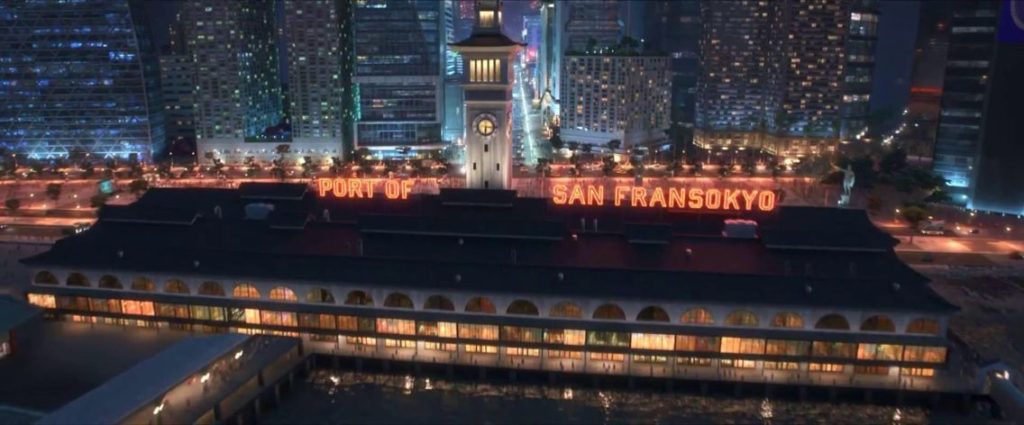
Unfortunately, to achieve my aims in making San Fransokyo Wharf more than a food court, the Mermaid ride needed demolished. Instead, I managed to use this space for something California Adventure needs: a highly technological, thrilling dark ride. I placed it behind the facade of the San Fransokyo Ferry Building and its iconic “Port of San Fransokyo” neon sign. While it would need stretched and skewed a bit to hide a tall showbuilding, I think this structure would fill that space along the waterfront nicely, and with the same symmetry that the aquarium provides in the real world. Then, using the showbuilding’s roof to have a scaled model of the city of San Fransokyo in the distance would be a great little tool for extending the world and suggesting that “downtown” exists elsewhere.
Anyway, given that I already designed a Big Hero 6 E-Ticket for Fantastic Worlds, it makes sense to re-use it here. My concept is called BIG HERO 6: KAIJU CLASH, basically seeing guests attend the launch of a new, student-developed, seismic-stabilized Gyro-Sled meant to serve as evacuation vehicles in the event of an earthquake. Of course, when a seismic event begins, guests are rushed off to the Gyro-Sled hangar to take to the skies of San Fransokyo, only to discover that the rumble wasn’t an earthquake, but a giant creature emerging from the Pacific!
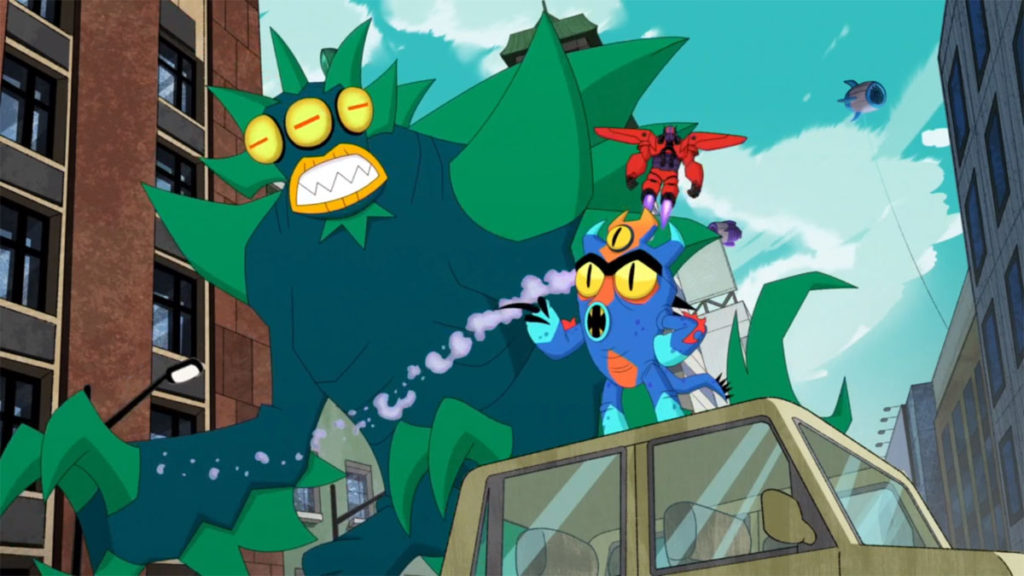
The ride would, of course, be a 4-person “flying bench” KUKA Robo-Arm system that would send guests soaring through the city with the Big Hero 6 team. To me, it feels not only like a kind of thrilling, whole-family E-Ticket that the park needs, but somehow, distinctly Californian. Maybe it’s the impact of Pacific Rim, but the idea of giant monsters rising from the Pacific on this side just like they do on Japan’s feels like a great coastal adventure.
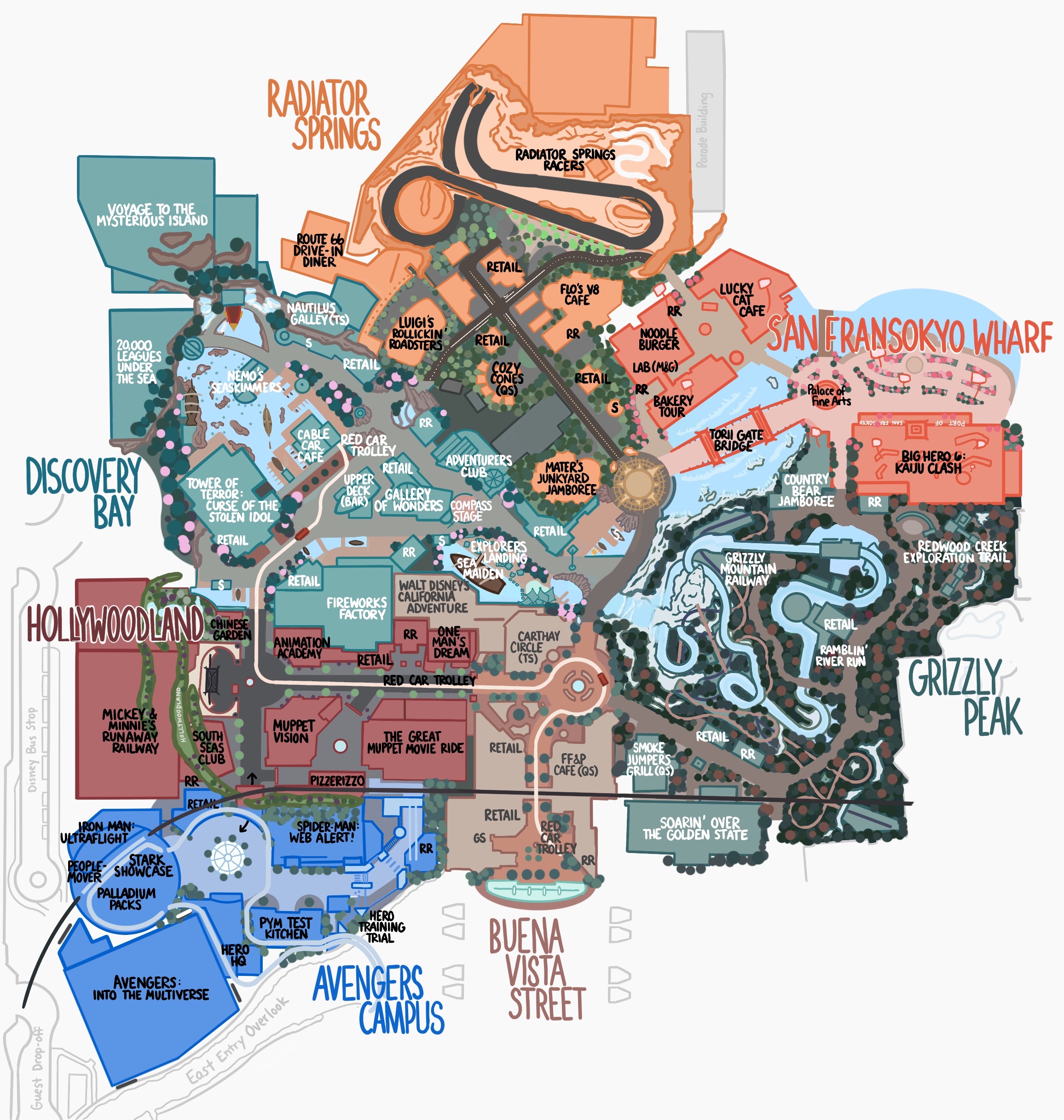
You can see that San Fransokyo Wharf is still a very small land, and is certainly wedged in. The back of the Kaiju Clash showbuilding would need to be clad as a lodge from Redwood Creek, for example… But the shot of the Torii Gate Bridge with Grizzly Peak beyond would – I think – become a signature shot for the park and resort.
So yes, I’m upset at the way San Fransokyo is really coming to California Adventure, but I do feel that sacrificing The Little Mermaid: Ariel’s Undersea Adventure to extend this land and make it more than a “label slap” would be a smart move and a worthy sacrifice.
Pacific Point
Background
The lands that border California Adventure’s lagoon have undergone a whole lot of name changes, border adjustments, and ret-cons over the years. When the park relaunched in 2012, the entirety of space around the lagoon had been grouped together as Paradise Pier, absorbed into a turn-of-the-century Victorian boardwalk aesthetic (but, as the park tends to do, filling that aesthetic with modern Disney and Pixar characters).

In 2018, the space was fractured when part of the amusement boardwalk became Pixar Pier, but the rest did not. Instead, some were split off as a new land called Paradise Gardens Park (even though there is no signage to differentiate the two). It’s certainly odd that two distinct, early-1900s amusement-pier-themed lands co-exist next to each other. Even odder, though, is the collection of rides Paradise Gardens ended up with – the Little Mermaid dark ride, the 1900s-stylized Golden Zephyr, the cartoonish Silly Symphony Swings orchestrated by classic Mickey, and the ’90s-incarnate Jumpin’ Jellyfish parachute drop tower, all wedged together at a bend in the performance corridor.
So, having eaten up the Mermaid real estate for San Fransokyo, I basically ended up with this little section of park before we hit the land that became Pixar Pier. The easiest choice would be to simply annex this space back to the Pier. (The Golden Zephyr could be “label slapped” with Up; Jumpin’ Jellyfish with Finding Nemo; the Silly Symphony Swings with Soul; the Paradise Gardens food court with Coco, and voila.) So of course, I didn’t do that. Instead, I decided to try to make this land super distinct from the pier next door, with a strong enough setting to justify its existence.
Build-Out
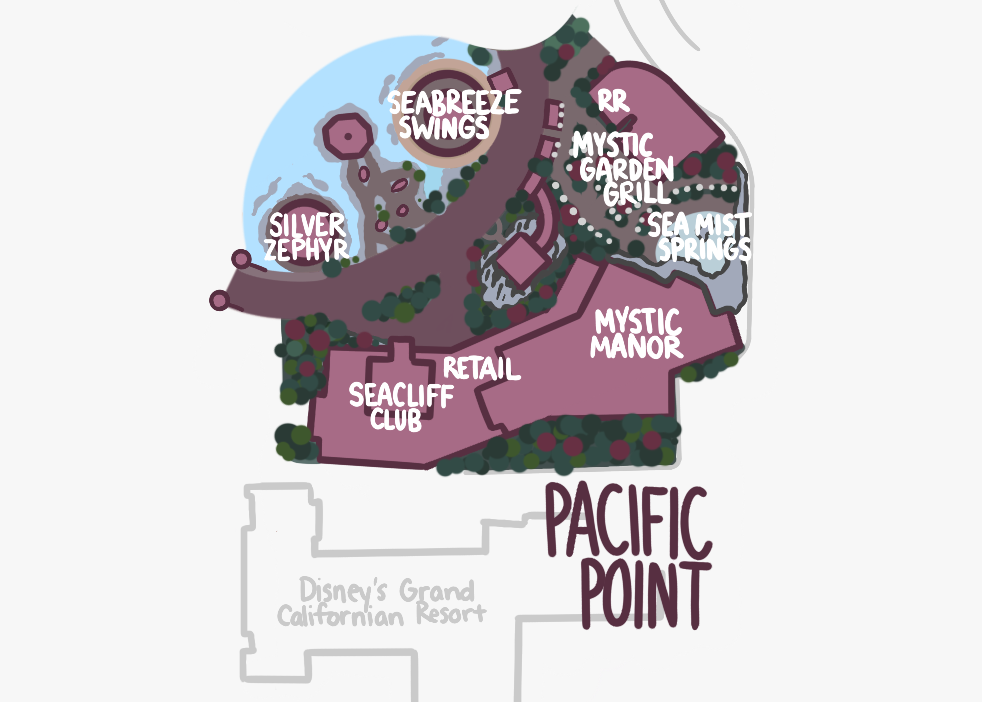
Instead, I decided to use this bend around the lagoon as Pacific Point – a rocky, misty little corner of the park; a Californian equivalent of Hong Kong Disneyland’s Mystic Point. This wonderful little land would need to use music and lighting to strike the right chord. Mysterious, but somehow magical; vintage, but not rundown; unusual, but not scary. In fact, I’d like very much if this land could feel stylistically connected to Discovery Bay; after all, it is the estate of a world-renowned adventurer…

Of course, the land’s main attraction would be MYSTIC MANOR. In my initial reimagining of the park, I’d placed a copy of this ride in Grizzly Peak, where it would definitely work well without many edits from its Hong Kong story… but with this piece of real estate made available by my switch to San Fransokyo Wharf next door, I decided to expand the ride’s context to this rocky, coastal mini-land. (If you don’t know anything about Mystic Manor – considered one of Disney’s best modern dark rides – be sure to make the jump to my Modern Marvels: Mystic Manor special feature.)
Even though I swapped the protagonist of this trackless, S.E.A.-influenced, musical haunted house for my build-out of Hollywood Studios, I feel like explorer, do-gooder, and antiques collector Lord Henry Mystic and his mischievous monkey Albert ought to stick around for this version. A straight up duplicate of the existing Mystic Manor would certainly fit, and probably become one of California Adventure’s most talked-about attractions. (It’s actually a shock that this ride hasn’t come to Disneyland yet.)
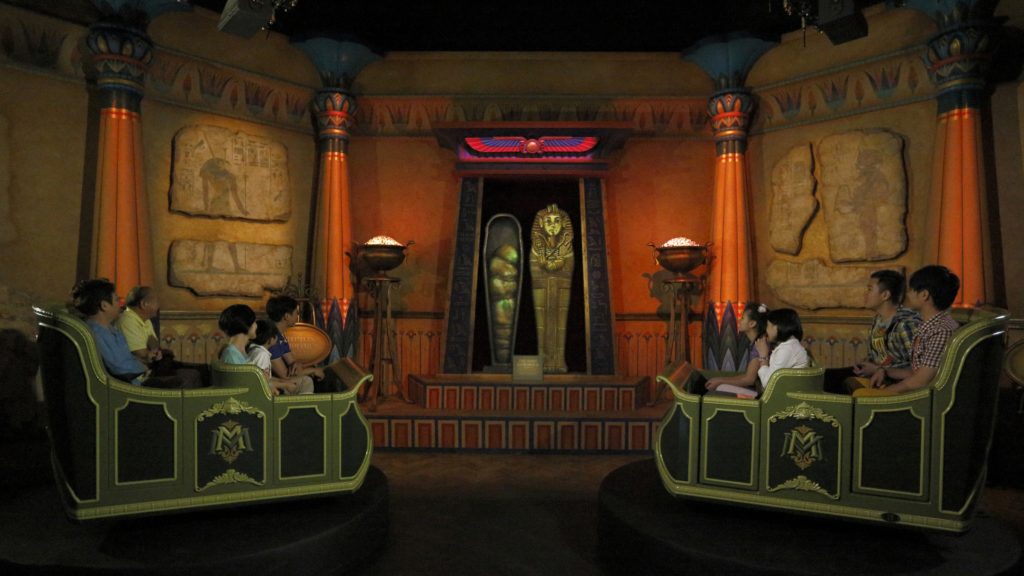
But if you really want to get creative, what if Lord Mystic’s penchant for antiques and enchanted treasures has seen him come to Pacific Point to assemble a collection of remnants of amusements gathered from along the Californian coast?
What if our tour through the home is recontextualized, with an enchanted carousel calliope cranking to life and filling the home with magical music dust? Imagine carousel horses that (literally) spring to life; rooms packed with treasures taken from closed-down dark rides – explaining collections of Egyptian treasures, Polynesian tikis, and Nordic gales as remnants of long-lost rides, maybe even some pulled from the never-built archives of Imagineering?

I’m just saying, reframing Mystic’s collection as remnants of Californian piers past would be a wonderful recontextualization, bringing new life to this musical dark ride. Plus, as part of Mystic’s reverence toward the past, several rides have been lovingly restored at Pacific Point for visitors to experience for themselves. That preseves the SILVER ZEPHYR and the SEABREEZE SWINGS, the latter stripped of its cartoon embellishments to create a duo of seaside swirling rides that look ultra-classic and simple.
I even included a rocky walk down to the water’s edge, passing by defunct ride vehicles relocated to Pacific Point and put on display for historical significance. (This could be a cute place to put actual archival ride vehicles, like one of Disneyland’s historic Rocket Jets or a PeopleMover train. After all, wouldn’t Mystic have collected those, too?)
Around the corner, I added MYSTIC GARDEN GRILL, a quick service eatery repurposing what’s left of the existing Paradise Gardens area (which I absolutely love), and further back, SEA MIST SPRINGS – a little splash pad for families to cool off.
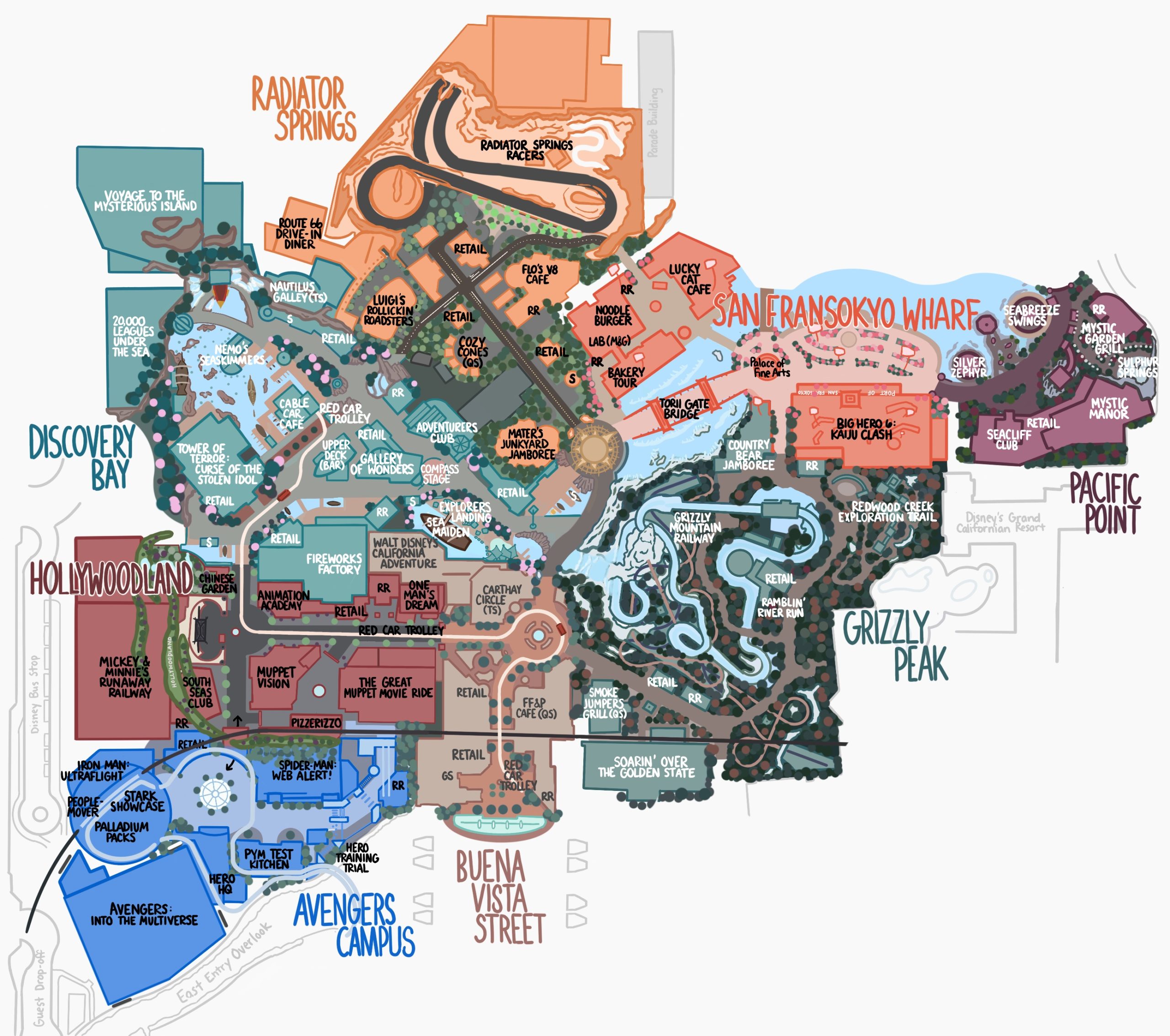
Buena Vista Street, Hollywoodland, Avengers Campus, Radiator Springs, Discovery Bay, Radiator Springs, San Fransokyo, and Pacific Point… I hope you can see how I’ve taken the ideas set forth in the “DCA 2.0” redesign and applied them here; gorgeously-stylized lands that recall Californian places and stories and futures, filled with optimism and character and energy.
There’s just one land left to reveal: the amusement area known today as Pixar Pier…



The thing about the 2012 redesign is that, while an idealized California appeals to out-of-towners, it also leans into DL’s identity as a local’s park by giving us places that we cannot visit in real life. I especially love the Carthay Circle restaurant and the Pan Pacific Auditorium gates, because they were torn down before I could ever see them.
Which is a long winded way of saying that the Figueroa tunnel does not belong in California Adventure, because I’ve driven there a hundred times. (To a lesser extent I’m not interested in putting the Chinese Theater in the park, because it’s still there, but I have to admit every time I’ve gone to the Chinese Theater I’ve had fun. Pasadena, however…)